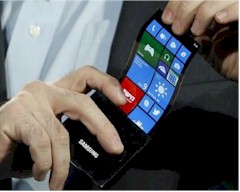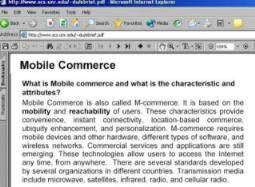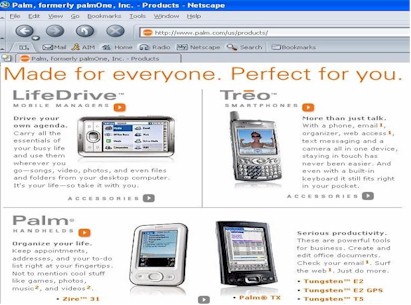an introduction

| M-COMMERCE
an introduction |
 |
 |
This web page has audio clips - just click on the icon (like the one to the left) and you can hear Prof. Richardson's voice adding additional information to topics on the page. |  |
turn on your speakers to hear audio clips |
| . | This page
used in the following courses taught by Prof. Richardson
.
|
| LEARNING
OBJECTIVES |
After completing
reading this unit, and listening to the lecture in class, student will
have information about:
o The
evolution and adoption of mobile computing
WTGR |
 |

Sol L. was a student in MGD415 at UTM in March 2008. Click on Sol's image to hear his comments, in Korean, providing an intro to the concept of m-commerce |
| We have many examples from
history - humans developed the concept of the photograph to more accurately
represent the human face because artists' renditions were not perfect.
Because humans see in colour, it was natural that humans would then develop
colour photography. Since we do not see just static images, but rather
moving images, it is natural that we would learn to create moving images.
And since humans like to see and hear what they sense, it is logical that
we would be able to add sound to moving pictures.
http://people.senecac.on.ca/tim.richardson/audio/audiohumans.wav http://www.youtube.com/watch?v=wBDCWwsi3VE |
| Bendable screens
a 2013 update  |
Within days
of each other (first week of Jan 2013), Queen's University profiled a bendable
screen for use in tablets and smartphones,
www.hml.queensu.ca/paperphone and Samsung debuts a bendable smartphone screen at the CES show in Vegas.
|
| The
origins
and growth of mobile and wireless commerce  |
From a White Paper on Personification's
web site
the url was http://www.personification.com/Visual/White/mobilecomp.html "The rapid growth in mobile
telephony in recent years provides a strong model for the adoption of undeterred
mobile computing...Nokia estimated that there will be a billion mobile
phone subscribers worldwide by 2005.(proven true by the end of 2006, there
is now 1 billion cell phone accounts worldwide) The
rapid transition from fixed to mobile telephony will almost certainly be
followed by a similar transition from fixed to mobile computing in the
near future.
narrow windows of opportunities audio and mobile knowledge networking." |
| The
origins
and growth of mobile and wireless commerce |
Personification Inc. notes
that mobile computing is the fourth wave of an
ongoing computing revolution. It follows the earlier mainframe, minicomputer,
and microcomputer waves.
Personification Inc. is a Toronto based company involved in ..."humanizing knowledge acquisition" .. as their site said in 1999 |
|
Convergence |
Convergence
is driving wireless and m-commerce.
Three converging trends
will grow at an annual rate of 24 percent
|
 |
During
the 3rd week of October 2008 Richardson was interviewed live on CTV Newsnet
for a story about the possibility that cellphone and internet use may be
effected by an economic downturn in the economy. Richardson provided several
examples of how cellphones and the internet are such an integral part of
everyday life that it is difficult to imagine much "cutting back" of these
technologies and services. Parts of Richardson's interview on TV were also
delivered as text on the CTV website.
www.ctv.ca/servlet/ArticleNews/story/CTVNews/20081023/essentials_study_081023/20081023/ also posted on http://people.senecac.on.ca/tim.richardson/video/CTVInterviewOnGPS.wmv |
 |
Many of the
professional service firms, such as the accounting firms, law firms and
management consulting companies have addressed m-commerce in the PR material
on their websites. PricewaterhouseCoopers had a particularly good note
on m-commerce since it addresses the all encompassing aspects of its effect
on all business categories.
WTGR "The convergence of wireless devices and the Internet is creating an important new channel to market — and the next wave of change across industries. Mobile business, or m-business as it has come to be known, will enable organisations in every industry to
formerly at www.pwcglobal.com/extweb/mcs.nsf/docid/CD62BE635F4F749C852569DD0054B892 |
| Benefits
of M-commerce
|
"M-commerce promises to make shopping easier, more personal and, perhaps, even save consumers time and money" Some benefits of M-commerce such as:
|
| Benefits of M-commerce | Toshiba explains
Feasibility of M-commerce: "Given the recent tendency to over-hype the promise of wireless technologies and 3G mobile networks, many consumers are sceptical when it comes to predictions about how m-commerce will transform their lives. According to some IT experts, in the future, consumers will be able to shop using a handheld computing device, PDA, wearable computer or mobile phone. In virtually any place – malls, restaurants, hotels, airports and other locations – this user will be able to receive coupons, download information, receive sales offers, and perform credit card transactions. In such future scenarios, m-commerce means that customers can shop anywhere, anytime." |
| M-commerce
|
E-Commerce Times explains
"Part 2 [ ecommercetimes.com/story/55554.html]
Part 3 [ ecommercetimes.com/story/55656.html
]
|
| M-commerce
Device Proliferation |
WTGR's analysis
of M-commerce
All the opportunities cited in 2006, 2005 and 2004 have had to deal with one giant problem Too Many Different Devices You can refer to it is Device Profusion if you like fancy terms, (a term used by Andrew Burger in Jan 2007) but the bottom line is that there are too many players trying to get in on the action, and as a consequence it is tough for companies to try and develop software and hardware that allows a user to use several devices in an interconnected way. "It seems that in its new life, wireless is facing fewer technological changes and a greater number of business and marketing issues. The industry has followed a tradition of "overpromising and under-delivering," Yankee Group analyst Roger Entner said.I (WTGR) see the future solution depending on marketing, not technology: ... meaning that successful companies, good at marketing, will (in a Darwinian way) survive, and weaker companies, products, systems will die out. |
| M-commerce
|
|
| M-commerce
|
The reason for
using the allegorical story of VCRs and DVDs re: m-commerce is because
the DVD industry (2006-2007) is facing a new problem, similar to the m-commerce
challenge of device profusion.
|
Maria F., Craig S., Daniela
S. of MRK410 Found this information on M-Commerce from the University of
Nevada at Reno
 |
 |
 |
 |
Drivers
"The major drivers are large number of users of Mobil devices, especially cell phones. Using a cell phone is becoming a culture in some places. Prices are declining, venders are pushing it, and EC is growing rapidly. Commerce is driven by its characteristics and attributes."
Different Applications
Finance and Applications"Many Ec applications in the service industry, such as banking, travel, stocks, and more can be conducted with wireless devices. Shopping can be done from mobile devices, too."
Intrabusiness Applications"Large number of Intrabusiness applications, including inventory management, sales force automation, wireless voice, job dispatching, wireless office, and more are evident inside organizations"
| Physical
Limitations
of mobile devices, which need to be addressed before m-commerce can fully develop  |
.
.
|
| Physical
Limitations
of mobile devices |
"Wireless
devices demand new models of information delivery and knowledge management,"
says Dr. Mark Chignell, CTO of Personification Inc. and head of the Interactive
Media Lab at the University of Toronto. http://imedia.mie.utoronto.ca/
|
| Physical
Limitations
of mobile devices |
To
allow more data to be viewed on the cellphone screen, Personification has
developed 2 technologies, namely TextSummary and PhoneSummary
|
| Physical
Limitations
of mobile devices |
however, despite this trend, Friedman cautions "...You can't build much of a display into a mobile phone without seriously compromising its portability, and unlike computers, most mobile devices are designed to be operated with one hand.... The killer app for the wireless Internet may not be traditional Web browsing at all — at least not in the short term — but direct, person-to-business electronic commerce. In effect, the wireless device becomes a combination of interface, credit card, smart card and ATM." Computing Canada is published
by The Transcontinental ITBusiness Group
|
| KEY
POINTS  |
In reading articles
like Friedman's, it should make you aware that many things in the mobile
market are undecided at present - there is no certainty as to what technology
will be applied, will it be WAP, or something coming after WAP, and it
is not certain what customers (the ultimate "voters") will want to do with
the new options.
What you should keep in mind in evaluating such articles is the outstanding question of what the customer will want to do with the features that become available. Just because you can add a lot of features to a cell phone doesn't mean people will want to use those features, they may be drawn into separate devices such as the PDAs instead of clogging up the cell phone with too many FABs. Audio - failure to consider the marketing aspects of a watch |
| What
does
wireless mean to the human experience? |
n
|
| Q.
Who are some
of the early players in the wireless web access developments? A - Phone companies
|
|
| Technological
Environment
GSM
2008
|
"I was able to apply your teachings recently when I read an online article with references to the 6 Environments Influencing Business. More specifically, the Technological Environment." David notes
with info from a National
Post article 2008 Jan 15
The article was at
|
| Technological
Environment
GSM
2008
|
The contribution by David
S. prompted me to have a short section on the difference between CDMA
and GSM
CDMA EVDO GSM EDGE SIM In cellular service there are two main competing network technologies: GSM - Global System
for Mobile Communications (see www.gsmworld.com
)
The GSM Association is an international organization founded in 1987 (in Europe) and widely used in Asia and Europe CDMA was developed by Qualcomm in the United States, has been the dominant network standard for North America and parts of Asia EVDO, also known as CDMA2000, is CDMA's speeded up CDMA with a downstream rate of about 2 megabits per second EDGE (from GSM) meansEnhanced Data Rates for GSM Evolution - is rates of up to 384 kilobits per second SIM Subscriber Identity
Module (SIM) cards: "In the United States only GSM phones use SIM cards.
The removable SIM card allows phones to be instantly activated, interchanged,
swapped out and upgraded, all without carrier intervention. The SIM itself
is tied to the network, rather than the actual phone. Phones that are card-enabled
can be used with any GSM carrier."
|
| What
are
some of the products in m-commerce in 2005 |
 |
"...
the shift to wireless"
 |
April 2000 "Wireless To Dominate Web by 2001" - it didn't happen Sept 2001 "Study: M-Commerce Faces Slow-Growth Future" Nov 2001 "Whatever Happened to M-Commerce?" |
| M-Commerce
Hype M-Commerce
|
Yankee Group mobile analyst Adam Zawel told the E-Commerce Times. "There needs to be a reason to make a purchase using your wireless device. No one's going to bother with an inferior experience on wireless when they can do it on their home PC."
|
..
.On
this page there are several quotes from ecommercetimes.com. Permission
was given by Richard Kern, Associate Publisher of the E-Commerce Times,
in an email to Prof. Richardson 2004 Dec 10th, a hard copy of the email
is kept on file in Richardson's permissions binder.
permission to quote from
PROFITguide magazine given by Editor Ian Portsmouth by email 2004
Dec 07. Copy of email kept on file in permissions
binder.
.
bbb
 |
|
||||
| Prof. W. Tim
G. Richardson Creative Commons Attribution-NonCommercial 3.0 Unported License (see http://creativecommons.org ) - this
means other professors and teachers and students can use my stuff for teaching
and learning without having to ask first
|
bbb